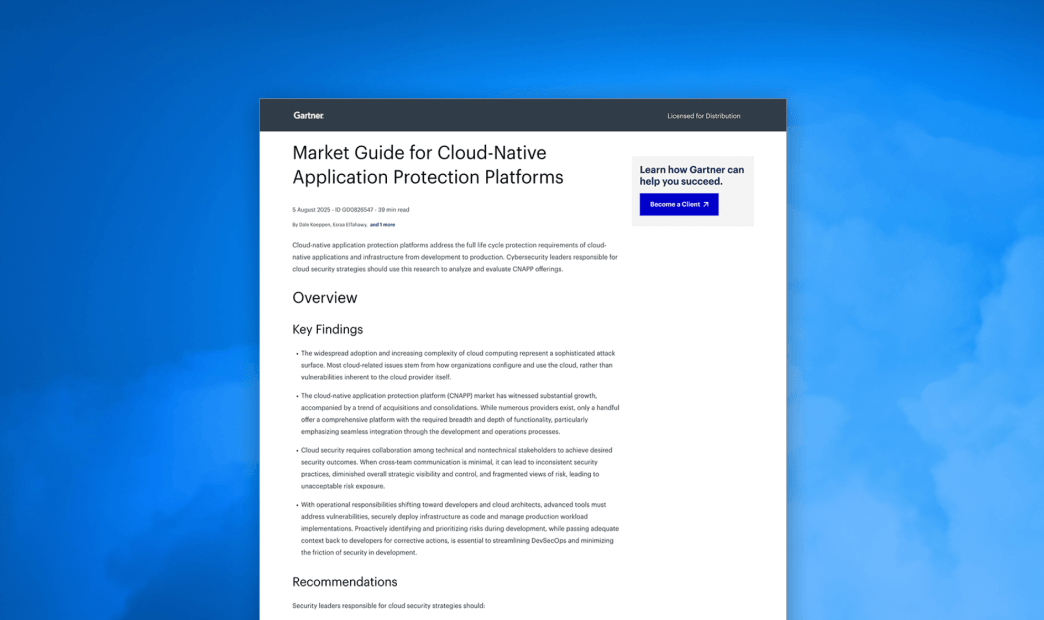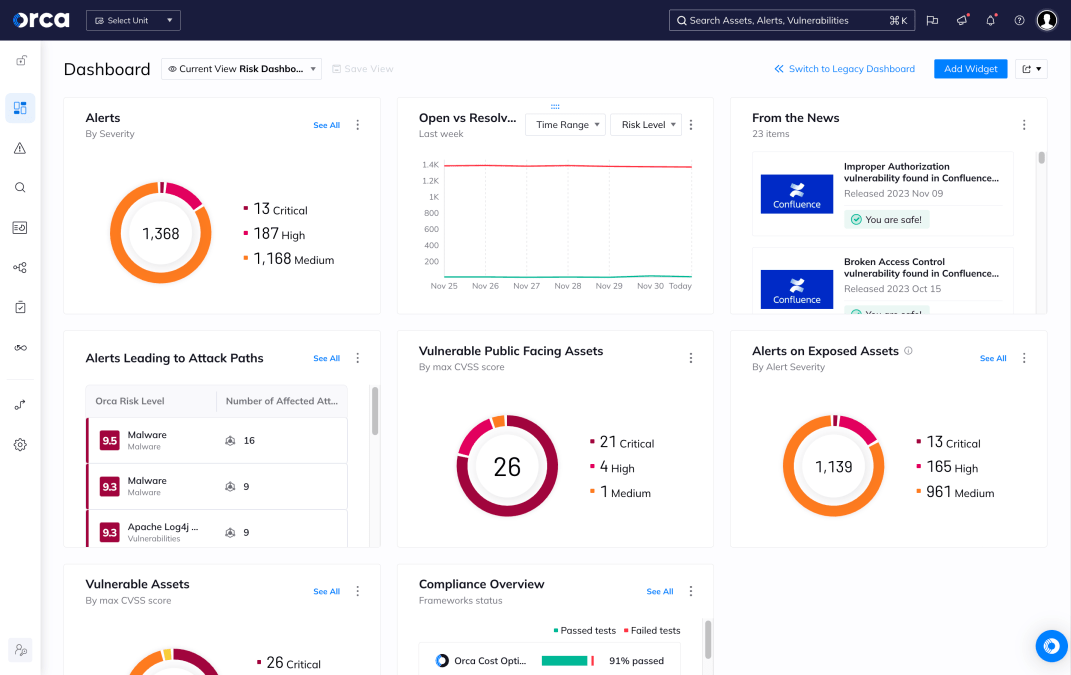As organizations scale their use of cloud-native technologies, security teams face mounting pressure to keep pace with increasingly complex environments. The 2025 Gartner® Market Guide for Cloud-Native Application Protection Platforms (CNAPPs) offers timely insights into how the CNAPP market is evolving, what buyers are prioritizing, and what capabilities leading platforms must deliver.
From consolidating tools to improving developer experience and unifying risk visibility, this year’s report reflects a maturing market, one that’s becoming central to how security, DevOps, and development teams work together to reduce cloud risk.
In this blog, we present our top six takeaways from the Gartner CNAPP report along with our recommendations.
What is a CNAPP?
CNAPP is a unified security solution that protects cloud-native applications across their entire lifecycle—from development to deployment and runtime. First introduced by Gartner® as a cloud security category, CNAPP combines capabilities such as CSPM, CWPP, CIEM, DSPM, and more into a single unified platform. We feel this consolidation helps organizations break down silos, reduce complexity, and prioritize risks based on deep context rather than isolated findings.
What’s driving CNAPP adoption?
In this year’s report, as per our understanding, Gartner mentions three driving factors behind the increasing CNAPP adoption:
- The need to unify risk visibility across IaaS, PaaS, and the application lifecycle, which siloed tools can’t achieve.
- A push to reduce complexity and blind spots by consolidating overlapping security tools into a single, integrated platform.
- The demand for seamless, low-friction security integration into DevOps workflows, enabling developers to maintain speed while staying secure.
“By 2029, 40% of enterprises that successfully implement zero trust within cloud service provider environments will rely on the advanced visibility and control capabilities offered by CNAPP solutions.”
2025 Gartner Market Guide for Cloud-Native Application Protection Platforms (CNAPPs)

Top 6 takeaways from the 2025 report
Here are our top six takeaways from this year’s Market Guide.
1. Buyers are prioritizing comprehensive CNAPP capabilities
Gartner notes that “only a handful [of vendors] offer a comprehensive platform with the required breadth and depth of functionality, particularly emphasizing seamless integration through the development and operations processes” (2025 Gartner Market Guide for Cloud-Native Application Protection Platforms (CNAPPs)).
We further learn that the report reinforces that mature CNAPPs must consolidate CSPM, CWPP, CIEM, container scanning, and more, into a single cohesive platform, reducing the need for point tools and enabling more accurate risk management.
Gartner also highlights the operational benefits of platform consolidation, including lower overhead, fewer consoles, and improved coordination across teams.
The Orca Cloud Security Platform is an agentless-first CNAPP that also delivers real-time runtime protection for wherever organizations choose to use it. Orca provides full visibility and comprehensive capabilities that span the entirety of the application lifecycle and your multi-cloud estate.
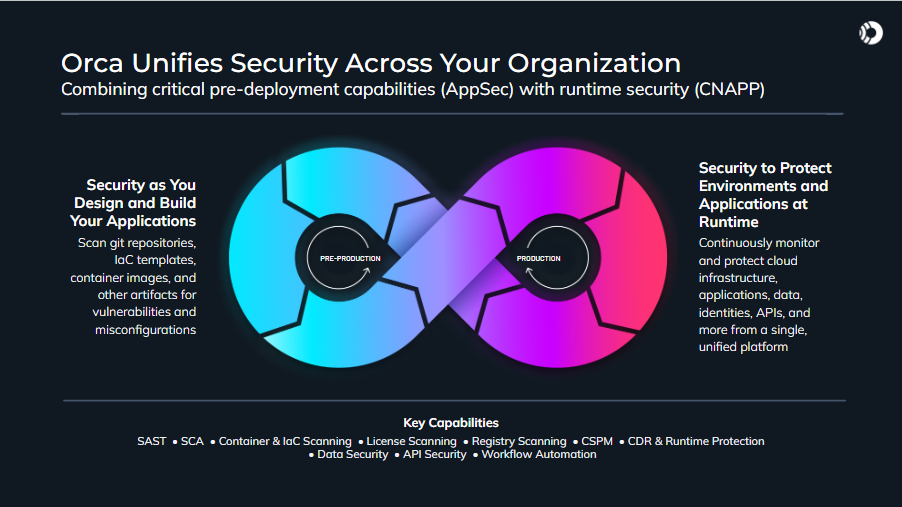
2. CNAPPs must secure the entire application lifecycle
According to Gartner, “CNAPP offerings operationalize cloud-native application risk analysis by “connecting the dots” to help understand the effective risk throughout the multiple layers of a modern cloud-native application.” The report says, “Prioritizing the risk findings is critical, as developers and security professionals are overloaded with the alerts and findings of siloed tools” (2025 Gartner Market Guide for Cloud-Native Application Protection Platforms (CNAPPs)).
To address this, Gartner recommends platforms that cover development artifacts like IaC and container images, as well as production environments, with consistent policies and feedback loops.
Orca extends CNAPP capabilities across the entire software development lifecycle with comprehensive Application Security (AppSec) features. This includes Infrastructure as Code (IaC) Security, Static Application Security Testing (SAST), Software Composition Analysis (SCA), Secrets Detection, and Source Code Management (SCM) Posture Management.
To ensure seamless collaboration, Orca provides two-way integrations with ticketing systems, SCM platforms, and IDEs, enabling security issues to be identified, prioritized, and remediated directly where developers work, well before they reach production.
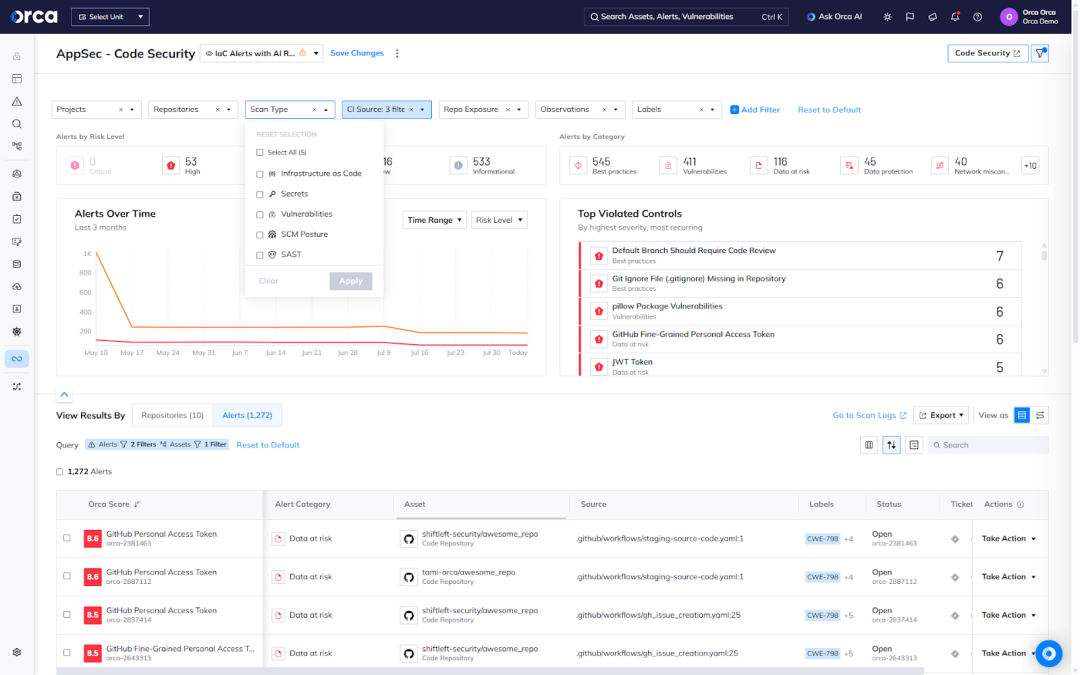
3. GenAI is transforming cloud risk detection and remediation
Gartner notes that CNAPP vendors are “increasingly incorporating generative AI (GenAI), common language interpreters, machine learning (ML) and large language models (LLMs) to reduce management overhead, offer policy recommendations, and enhance pattern analysis for threat detection and response” (2025 Gartner Market Guide for Cloud-Native Application Protection Platforms (CNAPPs)). These capabilities are designed to reduce mean time to resolution (MTTR) by embedding actionable fixes directly in the developer workflow.
In addition to faster response times, Gartner highlights how GenAI, machine learning, and large language models can improve threat detection and reduce alert fatigue, making security more scalable across the enterprise.
The Orca Platform harnesses GenAI to accelerate response and improve outcomes across the entire cloud security lifecycle. With AI Remediation, for example, users can generate tailored and targeted AI code fixes and remediation instructions on demand, and in many cases, apply them directly at the source, from cloud to code origin. These and other capabilities are powered by Orca AI, a built-in GenAI engine that boosts productivity, reduces mean time to resolution, and helps teams stay ahead of risk.
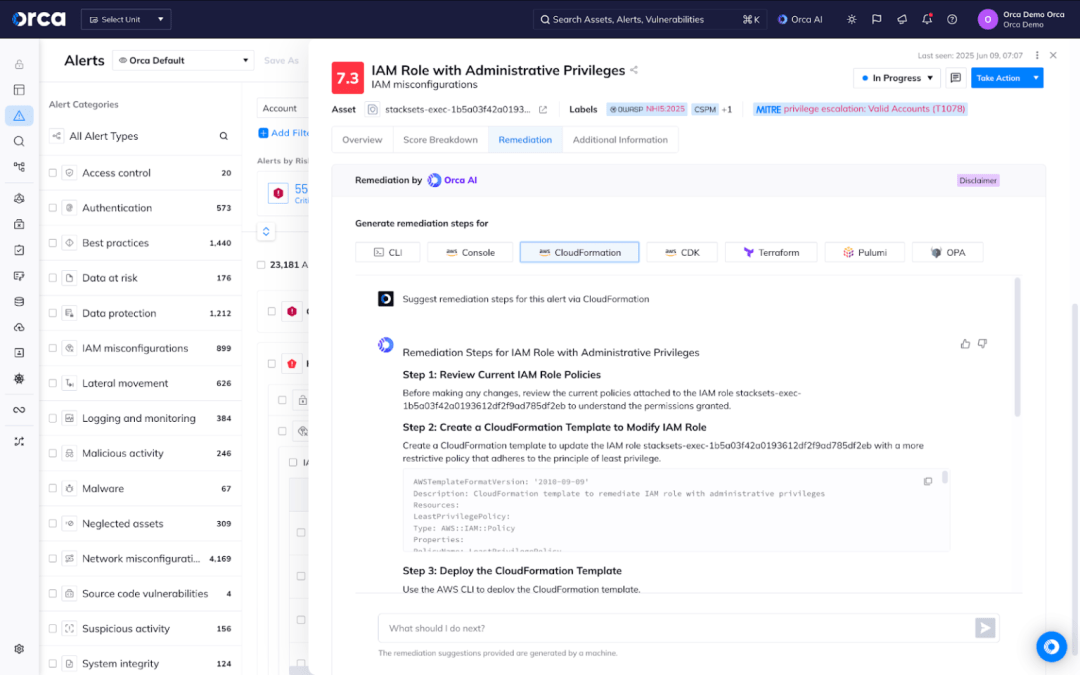
4. Developer experience is a strategic priority
Gartner stresses that security tools must evolve to reduce friction and meet developers where they work. “Information security’s role shifts to one of providing the guardrails throughout the entire development pipeline and avoiding gating developers throughout the development process” (2025 Gartner Market Guide for Cloud-Native Application Protection Platforms (CNAPPs)).
This shift reflects growing consensus that DevSecOps success depends on seamless security integration that doesn’t slow down builds with blockers or require teams to switch between tools.
The Orca Platform makes security a natural extension of how and where developers work. It offers deep, bidirectional integrations with ticketing systems like Jira, ServiceNow, and Linear, SCM platforms including GitHub, GitLab, and Bitbucket, and CI/CD pipelines, so developers can receive, triage, and fix issues without disrupting their workflow.
Just as important, Orca ensures that every alert includes the context developers need to act quickly and confidently, closing the gap between detection and resolution.
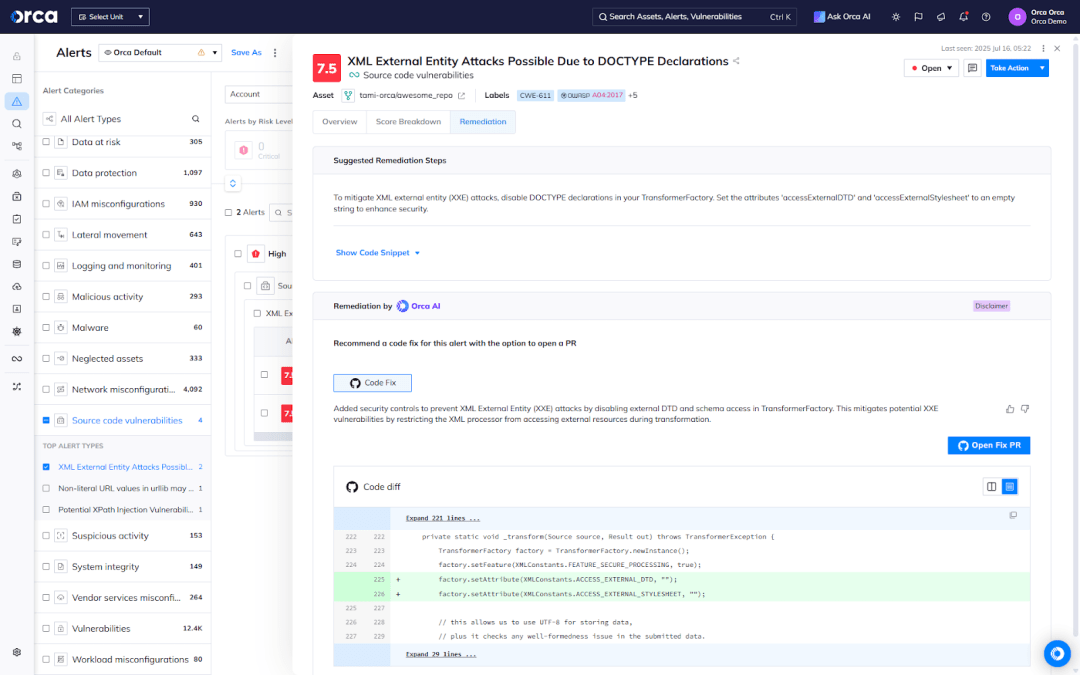
5. Risk prioritization depends on unified data and graph-based context
Gartner highlights the importance of data unification and analytics for prioritizing the risks that matter most. “Mature CNAPP solutions benefit from a single data lake, data model and unified graph database for all event logging, reporting, alerting and relationship mappings, which greatly improves the ability to correlate the data accurately” (2025 Gartner Market Guide for Cloud-Native Application Protection Platforms (CNAPPs)).
By mapping relationships across assets, identities, workloads, and code, CNAPPs can pinpoint the highest-impact risks and assign them to the correct team or owner for remediation.
The Orca Cloud Security Platform prioritizes remediation by analyzing risk holistically and dynamically, factoring in the full and evolving context of your entire cloud estate. By combining deep and comprehensive coverage with advanced capabilities like Reachability Analysis, Orca identifies the small subset of risks that truly matter, including toxic attack paths that could lead to your most sensitive cloud resources.
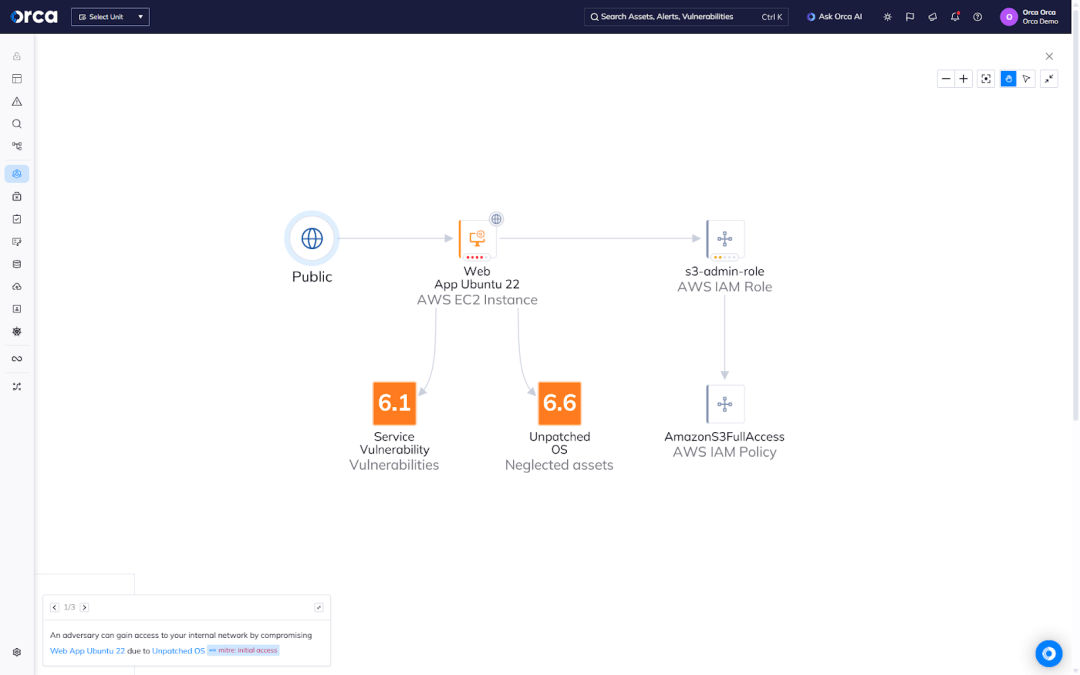
6. Open integration architecture is essential for collaboration
While consolidation is driving CNAPP adoption, Gartner emphasizes the need for platforms to support open integration models. Many organizations rely on legacy tooling, specialized point solutions, or in-house workflows. “Certain CNAPP solutions fall short in establishing strong technology partnerships and offering extensive integration options with other vendors and stand-alone tools” (2025 Gartner Market Guide for Cloud-Native Application Protection Platforms (CNAPPs)).
Open integration supports more flexible deployments, improves communication across tools, and enables cross-functional teams to share a consistent view of risk.
At Orca, we’ve designed our platform to be integration-first, so it can deliver the right security intelligence to the right teams, at the right time and in the right place. Whether teams are working in a ticketing system, SCM platform, IDE, or SIEM, Orca ensures they have the context they need to act quickly and effectively.
By supporting flexible, bi-directional integrations, Orca helps break down silos and fosters the kind of cross-functional coordination that Gartner identifies as critical for CNAPP success.
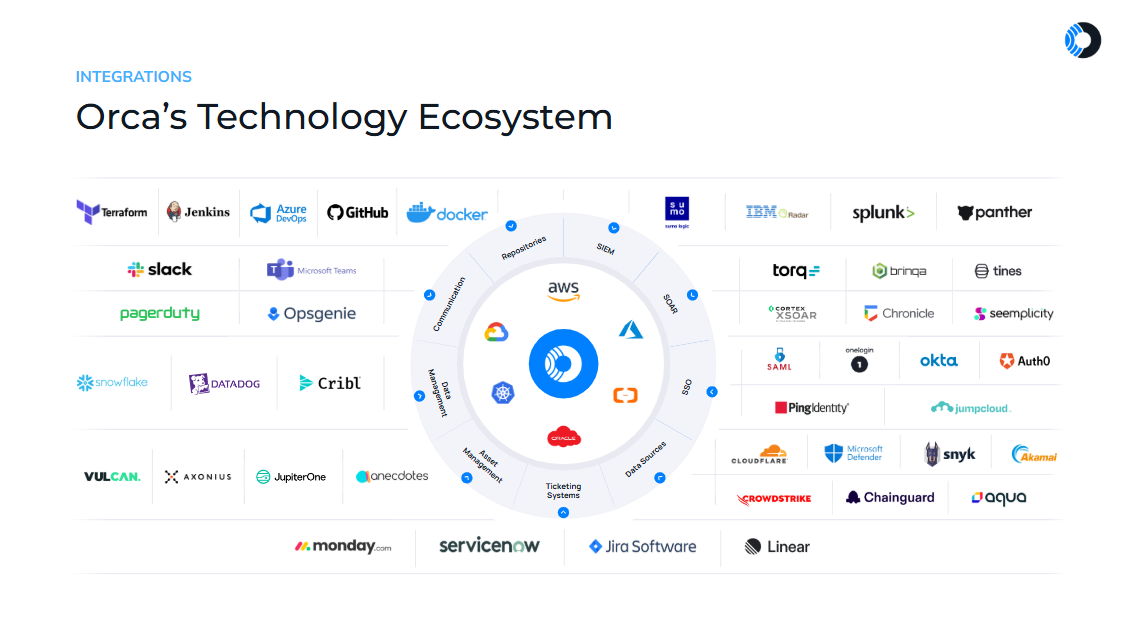
About the Orca Cloud Security Platform
Recognized as a representative vendor in Gartner’s Market Guide for CNAPP report, Orca offers a unified and comprehensive cloud security platform that identifies, prioritizes, and remediates security risks and compliance issues across AWS, Azure, Google Cloud, Oracle Cloud, Alibaba Cloud, and Kubernetes. The Orca Cloud Security Platform leverages Orca’s patented SideScanning™ technology to provide complete coverage and comprehensive risk detection.
Learn more about CNAPP
To learn how Orca can help you adopt CNAPP best practices, schedule a personalized walkthrough of the Orca Platform.
In line with Gartner’s recommendations, Orca welcomes proof of concept (POC) evaluations and is committed to ensuring our Platform meets your needs and delivers measurable results.
Gartner, Market Guide for Cloud-Native Application Protection Platforms, Dale Koeppen, Esraa ElTahawy, Neil MacDonald, 5 August 2025.
GARTNER is a registered trademark and service mark of Gartner, Inc. and/or its affiliates in the U.S. and internationally and is used herein with permission. All rights reserved.
Gartner does not endorse any vendor, product or service depicted in its research publications, and does not advise technology users to select only those vendors with the highest ratings or other designation. Gartner research publications consist of the opinions of Gartner’s research organization and should not be construed as statements of fact. Gartner disclaims all warranties, expressed or implied, with respect to this research, including any warranties of merchantability or fitness for a particular purpose.
This graphic was published by Gartner, Inc. as part of a larger research document and should be evaluated in the context of the entire document. The Gartner document is available upon request from Orca Security.
